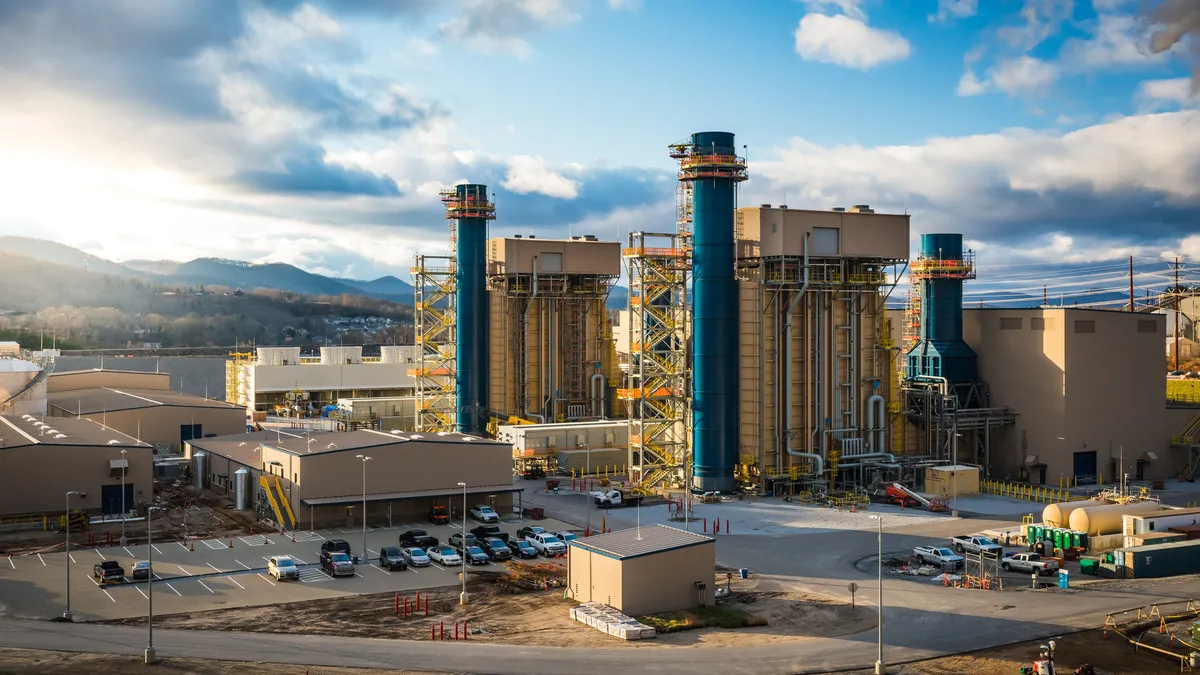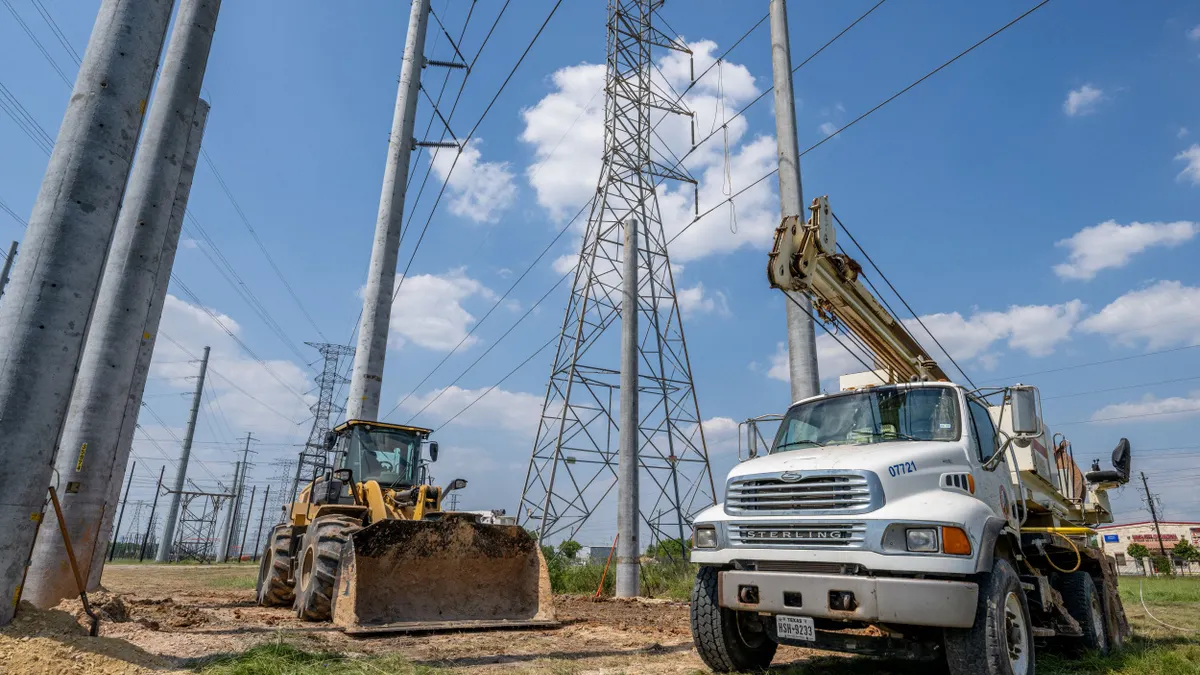This year's DistributTECH conference is the biggest ever, with organizers announcing yesterday that more than 11,000 people are expected to pile into the San Diego Convention Center this week. Although one of the main attractions — Secretary of Energy Ernest Moniz's hair — was not able to attend, the excitement was palpable ahead of the keynotes from two leading California utility CEOs and a world-class theoretical physicist. Utility Dive was on hand in the packed ballroom to hear the keynotes. Here's some of the highlights we thought were the most compelling:
SDG&E CEO: Utilities need to dispel 'myth that our industry is opposed to change'
We can’t say for sure, but it sure seems like SDG&E CEO Jeff Martin took our State of the Electric Utility survey, because he — like the strong majority of respondents — expressed confidence in the future of the utility industry.
“This is actually one of the most exciting times in the history of energy in our country,” he told the crowd in his opening keynote. “Our industry is at the cutting edge of many important changes, from renewable energy to conservation to clean transportation.”
The beginning of this young century, Martin explained, should be known as the “age of discovery” for electric utilities. Just as explorers like Magellan, De Gama and others set out to challenge the prevailing wisdom of the time, so too utilities are pushing the boundaries of what we think is possible for electricity.
"We too are a part of a transformational change,” just like the explorers of old, he told the crowd. And with that change comes opportunity. New entrepreneurs — his label for both the explorers and utility innovators — will have the opportunity to “discover or redefine a new world for energy” and “chart a course to more customer choice, cleaner fuels, and the inclusion of more emerging technologies.”
The electric utility industry will see more change in the next ten years than in the last 100, he said, but to seize the opportunities this disruption presents, the industry must work together to disprove the conception that utilities are averse to innovation.
“Just as in the 15th century the myth that the Earth was flat was dispelled, all of us can participate in dispelling the myth that our industry is opposed to change,” he said.
With that, Martin endeavored to give the crowd a model for the utility of the future — the SDG&E model. The CEO outlined three “leadership initiatives” that are central to SDG&E’s transformative mission — expanding renewables, improving support for electric vehicles, and utility rate reform.
Martin hailed California’s efforts to decarbonize its economy, noting that this year SDG&E expects to supply 33% of its electricity from renewables — and that's not including rooftop solar.
“That will make us the first utility to meet or exceed the 33% threshold and will do so before the California-mandated 2020 deadline,” he said.
Martin touted SDG&E’s rooftop solar programs, saying that — contrary to popular beliefs about utility attitudes toward distributed generation — “we at SDG&E are aggressively trying to make it happen.”
Decarbonization for Martin doesn’t stop at the meter — SDG&E wants to power the electric vehicle market as well.
While San Diego has far and away the most electric vehicles for a city of its size, private industry has not kept up with electric adoption, Martin said. Customers who live in multi-unit dwellings comprise about half of SDG&E’s customers, but in the past five to seven years, private industry has only installed 14 charging stations at such residences, according to Martin.
“This whole segment of the population has been red lined from participating in clean transportation,” he said. SDG&E hopes to change that with its proposal to install more than 5,000 charging stations in its service area.
Finally, Martin said, electricity regulators in California and elsewhere must embrace rate reform and move consumers toward cost-based rates. As Utility Dive has reported, SDG&E says its higher-use customers have been unfairly subsidizing other customers to the tune of hundreds of millions of dollars a year.
Getting rid of that rate structure, which was established in the aftermath of the California energy crisis, is a “foundational step to improve customer service and expand innovation,” Martin said. Cost based rates are the “grand enabler” that allows the other innovations to happen.
“The evolution of the utility model, which includes things like rooftop solar, batteries, electric vehicles, day ahead pricing, time of use pricing, all of these depend on getting the rate structure correct, and getting it correct means moving toward cost-based rates,” he said.
Martin closed the speech much like he opened, imploring the crowd to transform utility business models.
“I challenge this audience to be active participants in defining a new world for America’s energy,” he said.
Edison CEO: Bet on industry change to be 'more evolutionary than revolutionary'
As far as utility executives go, Jeffrey Martin is one of the more forward-looking. His utility, after all, is already moving away from centralized generation and fossil fuels, and towards new business models.
That’s not always the case, even in California. Theodore "Ted" Craver, Jr., reminded conference attendees of that when he took to the podium. The chairman of the Edison Electric Institute — the trade group for investor-owned utilities — and CEO of Edison International wasn’t conservative in his remarks, but it was clear he had a wider audience to please than Martin.
“We think [the utility business] is going to change significantly, the change will be fundamental, that it will be transformative — timing to be determined," he said.
Craver’s selection of the most powerful forces shaping these changes won't surprise anyone: Environmental regulations, technological innovations, increased competition from third parties, and low or no load growth for utilities.
That alone may provide plenty of incentive to modernize the grid, but Craver said that’s not the main driver behind Edison’s smart grid investments.
“So why do we need to modernize the grid? Isn’t the one we have perfectly fine?" Craver said. "I think the primary reason is because our customers want it.”
More and more, power quality is becoming an issue for Edison, he continued. For many large customers — such as large businesses or industrial facilities — having the guarantee of reliable power is more significant than what they pay for it.
“Price is an important component,” he said, “but it’s not the only component, so it’s important for us to not be too myopically focused on the dollars and cents and really listen to our customers.”
“I think we will transition from electricity as a commodity to electricity as real value,” Craver added.
That may have been par for the course from the head of the Edison Electric Institute, but Craver’s second reason to modernize the grid raised hopeful eyebrows among the environmentalists in the crowd.
“We need to move toward a low carbon economy,” he stated matter-of-factly. In California, “the focus on driving to a low carbon economy is pervasive. It’s at the governor, it’s at the legislature, it’s at our local communities. This is very much a focus for policymakers.”
“But of course,” he quickly added, “we need to be able to do those things while still providing safe, reliable and affordable electricity to our customers.”
“For decades that has been our primary mission,” Craver continued, “and that really does not change.”
Craver outlined the four keys to decarbonization that utilities can use to benefit from the changes: Invest in the smart grid, expand and integrate renewables, take advantage of distributed energy resources like rooftop solar, and expand electrification to other industries.
The current transmission and distribution system, Craver said, was really built to handle peaks. On most days, SCE doesn’t even use half of the capacity that its grid can hold. There are ways to reduce line losses and “optimize the system” through efficiency programs, demand response, and smart grid technologies, he said.
As for renewables, Craver said that getting to California Gov. Brown’s goal of 50% renewables is less a matter of technical feasibility and more a matter of money.
“Yes, [the mandate] has some issues, some difficulties, but I don’t see it as an issue of if it can be done. It’s more a matter of, at what cost?” he said.
Craver listed off the kilowatt-hour costs of a number of renewable resources compared to the average electricity cost nationwide, an exercise that pointed out to everyone how cheap many clean energy technologies have become.
“What has really been taking place is that in the last few years the cost of renewables has come down dramatically and continues to decline,” Craver concluded.
But utility-scale renewables and distributed generation are different animals for utilities. From Wisconsin to Arizona, many utilities are moving to limit the rapid spread of rooftop solar in their service areas. Critics say Edison Electric Institute’s campaign to push fixed charges is an attempt to tamp down on customer-owned generation as well. But the trade group’s chairman displayed no such inclination at the conference.
“Customers want independence. They want control, and to be frank, they’re somewhat wary of the monopoly power of the utilities,” Craver said. “Distributed energy resources give consumers those choices.”
“We don’t see our role as trying to halt that process. To the contrary, we see our role as trying to facilitate that process,” he continued.
Utilities can use their resources to help enable the spread of distributed resources and create “custom pricing” for each customer, but much of their success will depend on where they’re located, Craver said. In foreshadowing many of the comments to come, the CEO told the crowd distributed resources are all about “location, location, location.”
“If we can locate a lot of these DERs in our more densely populated areas, then we can actually reduce costs and improve the efficiency of the system,” he said.
Finally, Craven told the audience to expand electrification into other realms of the economy, most notably transportation. The vast majority of vehicles still run on gas, he said, echoing Martin, but there are huge opportunities for utilities willing to take the plunge into electric vehicles.
In sum, the Edison International CEO took a more moderate tone in contrast to Martin’s aggressive pleas for utility transformation.
“I think the better bet is that the changes we’ll see in the electric sector will be more evolutionary than revolutionary,” he said. “But there is a meaningful chance that it will be dramatic and very fast. So our strategy is to provide our customers what they want, not what we want to give them.”
Michio Kaku: The first nuclear fusion plant will come online by 2020
The third and final keynote was a departure from the utility executives. Michio Kaku is a theoretical physicist, New York Times bestselling author, and has been a professor at CUNY, Princeton and Harvard. But most of all he's a technology futurist, and he came to DistribuTECH to give attendees a glimpse of the future.
Much of Kaku's speech was fascinating — think: one cent computer chips and smart contact lenses — but not of much direct interest to electric utilities. He did, however, make a prediction about nuclear power that could change the way we think of generation worldwide.
The first nuclear fusion test project, Kaku told the crowd, will come online in only about 5 years, in 2020. That technology, the physicist promised, will use seawater as a fuel, produce almost no nuclear waste, and produce more than ten times the energy it consumes. If even part of that is true, it could have huge implications for utilities and electricity markets worldwide.
Kaku finished his address by imploring the audience, like his predecessors, to not let innovation leave them behind.
"Be a surfer," he told the crowd, and ride the wave of technological development. Otherwise, he warned, you're likely to be drowned by it.





















